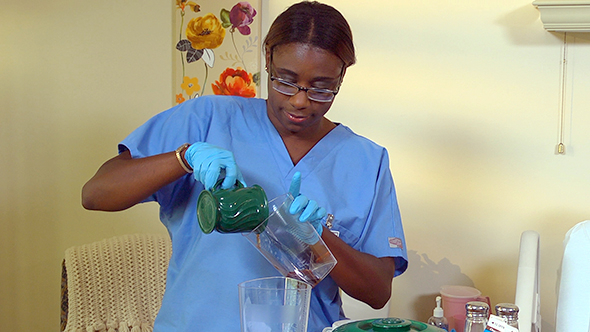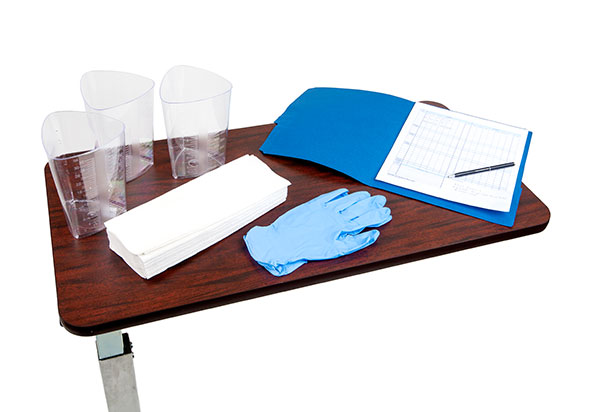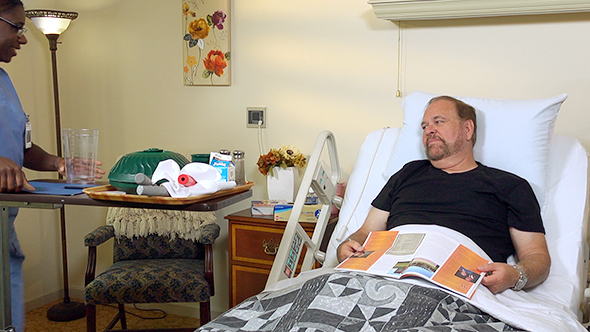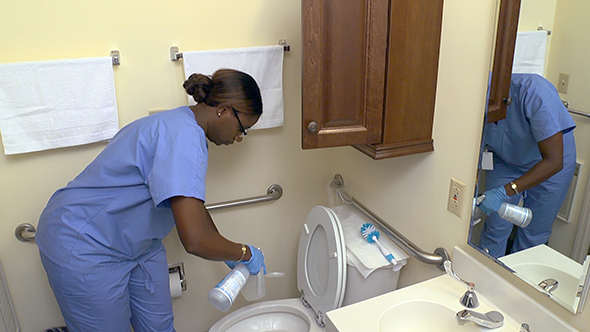Nutrition and Fluids
Select a Skill:
Take the Review Test:

Purpose

- The doctor or nurse may order intake and output (I&O) measurements.
- Intake is the amount of fluid taken in. All oral fluids are measured and recorded. So are foods that melt at room temperature, such as ice cream. The nurse measures and records intravenous (IV) fluids and tube feedings.
- Output is the amount of fluid lost. Output includes urine, vomitus, diarrhea, and wound drainage.
- I&O records are kept. They are used to evaluate fluid balance and kidney function. They also are kept when the person has special fluid orders.
- Intake and output are measured in milliliters (mL).
- You need to know that 1 ounce (oz) equals 30 mL, 1 pint is about 500 mL, and 1 quart is about 1,000 mL.
- You need to know the serving sizes of bowls, dishes, cups, pitchers, glasses, and other containers. This information may be on the I&O record or on the container. You may need to convert the amount into milliliters. To do this, multiply the number of oz by 30 (the number of mL in each oz).
- A measuring container for fluid is called a graduate. It is used to measure left-over fluids, urine, vomitus, and drainage from suction. It is marked in ounces and milliliters. Plastic urinals and kidney basins also have amounts marked. Hold the measuring device on a flat surface at eye level to read the amount.
- An I&O record is kept at the bedside. When I&O is measured, the amount is recorded in the correct column. Amounts are totaled at the end of the shift. The totals are recorded in the person’s chart.
- The urinal, commode, bedpan, or specimen pan is used for voiding. Remind the person not to void into the toilet and not to put toilet tissue in the receptacle.
Equipment
Roll cursor over items to see labels. For the purposes of clearly depicting the equipment, a barrier is not shown in this photo. When providing care, a barrier should always be placed on the surface before placing the equipment.

I&O record
Graduates
Paper towels
Gloves
Delegation
- Follow delegation guidelines. Before measuring intake and output, obtain this information from the nurse and care plan:
- If the person has a special fluid order
- When to report measurements—hourly or end-of-shift
- What the person uses for voiding—urinal, bedpan, commode, or specimen pan
- If the person has a catheter
- What patient or resident concerns to report at once.
- What observations to report and record
- When to report observations
Preparation

- Observe quality-of-life measures.
- Review the information under Delegation and Safety and Comfort.
- Practice hand hygiene.
- Collect the equipment.
Safety

- Urine may contain microbes and blood. Microbes can grow in urinals, commodes, bedpans, specimen pans, and drainage systems. Follow Standard Precautions and the Bloodborne Pathogen Standard when handling such equipment. Thoroughly clean the item with a disinfectant after it is used.
Comfort
- Promptly measure the contents of urinals, bedpans, commodes, and specimen pans. This helps prevent or reduce odors. Odors can disturb the person.
Procedure Video
Audio Description: OFFFollow-up Care

- Provide for comfort.
- Place the call light within reach.
- Complete a safety check of the room.
Reporting/Recording
- Report and record your observations, including:
- Urinary frequency, amount of urine, and habits when voiding
- Urinary incontinence or dribbling
- Burning sensation when voiding
- Cloudy, bloody, or foul-smelling urine
- Urine retention or voiding of small amounts
Review Questions
Select the best answer.
1. Which substance should the nursing assistant measure as part of a person’s intake?
Select the best answer.
2. Which substance should the nursing assistant measure as part of a person’s output?
Select the best answer.
3. When measuring intake and output, you may need to convert ounces (oz) to milliliters (mL). What does 1 oz equal?
Select the best answer.
4. How should you measure intake and output?
 With the graduate placed on the floor
With the graduate placed on the floor With the graduate held up toward the light
With the graduate held up toward the light In the urinal or other urine collection container
In the urinal or other urine collection container With the graduate at eye level on a flat surface
With the graduate at eye level on a flat surface
Select the best answer.
5. When should you total the amounts recorded on the intake and output (I&O) record?
 Once every 2 hours
Once every 2 hours At the end of the shift
At the end of the shift As soon as you record them
As soon as you record them Once at the same time every day
Once at the same time every day
You have completed the Review Questions for this skill. To take the Review again select the Start Over button. To proceed to another skill select from the dropdown menu. Select the Home or Back button to proceed to the next section.

